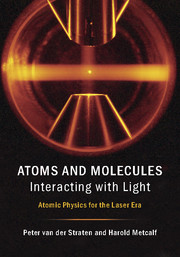Book contents
- Frontmatter
- Contents
- Preface
- Part I Atom–light interaction
- Part II Internal structure
- 7 The hydrogen atom
- 8 Fine structure
- 9 Effects of the nucleus
- 10 The alkali-metal atoms
- 11 Atoms in magnetic fields
- 12 Atoms in electric fields
- 13 Rydberg atoms
- 14 The helium atom
- 15 The periodic system of the elements
- 16 Molecules
- 17 Binding in the hydrogen molecule
- 18 Ultra-cold chemistry
- Part III Applications
- Part IV Appendix
- References
- Index
9 - Effects of the nucleus
from Part II - Internal structure
Published online by Cambridge University Press: 05 February 2016
- Frontmatter
- Contents
- Preface
- Part I Atom–light interaction
- Part II Internal structure
- 7 The hydrogen atom
- 8 Fine structure
- 9 Effects of the nucleus
- 10 The alkali-metal atoms
- 11 Atoms in magnetic fields
- 12 Atoms in electric fields
- 13 Rydberg atoms
- 14 The helium atom
- 15 The periodic system of the elements
- 16 Molecules
- 17 Binding in the hydrogen molecule
- 18 Ultra-cold chemistry
- Part III Applications
- Part IV Appendix
- References
- Index
Summary
Introduction
Atomic spectroscopy provided a wealth of information about nuclear physics before the advent of huge accelerator facilities. The multiple, closely spaced atomic spectral lines could be ascribed to various nuclear properties, including the existence of isotopes, the magnitude of the nuclear magnetic moments, and even quadrupole and higher-order non-spherical aspects of nuclear structure. Some aspects of these effects are discussed below.
Motion, size, and shape of the nucleus
In Chap. 7 it is assumed that the nucleus of the atom is a point particle located at rest in the center of the coordinate system. Since the nucleus is much heavier than the electrons and the size of the nucleus is much smaller than the radius of the electron's orbit, this is a good approximation. In this section the effects of the nuclear motion, size, and shape are discussed.
Nuclear motion
The kinetic energy in the Hamiltonian of the Schrödinger equation is represented by the operator p2/2m, whose constituent terms are the momentum operators px = −iħd/dx, and similarly for py and pz. But these operate only on the electron coordinates, and thus provide only its kinetic energy, and not that of the moving nucleus. As suggested in Chap. 7 the nuclear kinetic energy is small compared with that of the electron.
Consider that the motion of this two-body system may be divided into the overall center-of-mass motion and the motion of the constituent particles with respect to the center of mass. Then, in the center-of-mass rest frame, the total momentum of the constituents is zero so, for the two-body system of the hydrogen atom, MV + mv = 0, where upper (lower) case refers to the nucleus (electron). Then so the kinetic energy of the nucleus is smaller than that of the electron by the ratio of the masses, one part in 2,000 for hydrogen, and still smaller for heavier atoms. For this two-body system, the kinetic energy of the nucleus with respect to the center of mass can be included by making a simple correction by replacing the mass of the electron with the reduced mass μ = mM/(m + M) as in Eq. (7.29). For an atom, M ≫ m so μ ⋍ m (see Tab. 7.5).
- Type
- Chapter
- Information
- Atoms and Molecules Interacting with LightAtomic Physics for the Laser Era, pp. 149 - 163Publisher: Cambridge University PressPrint publication year: 2016



